Low Cost To Buy And Operate/High MPG
On paper the 2014 Mitsubishi Mirage ES Hatchback seems like a good option in the very competitive subcompact and small car segments. And for some, it may be the right car as it gets outstanding fuel economy, is easy to park and above all the list price is low. But the questions of how good of a car the Mirage is and what other choices there are might make looking primarily at price a too restrictive way to go car shopping.
Drivetrain
The front-wheel drive Mirage ES Hatchback is powered by a 1.2 Liter, DOHC, 12-valve, inline three-cylinder engine, producing 74 hp through the Continuously Variable Transmission (CVT), delivering an EPA rating of 37 city/44 highway/40 combined mpg. A five-speed manual transmission is standard but drops the fuel economy to 34/42/37.
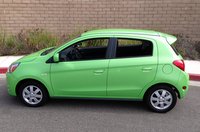
The gasoline-powered three-cylinder engine sounds like a diesel, but not the quiet 2014 versions found in the Chevrolet Cruze or Volkswagen Jetta. The little Mirage engine was loud, ran and idled rough, and had very poor low-end pulling power with only 74 lb-ft of torque. Add-in any passenger or cargo weight and it is asking too much for the engine to do much more than groan to get up to speed.
In 277 miles of 90-percent/10-percent highway/city driving, the CVT-equipped Clean Fleet Report Mirage ES averaged 43.2 mpg. At our average, the 9.2-gallon fuel tank would get you 397 miles down the road.
Driving Experience: On The Road
The 5-door 2014 Mirage Hatchback with the CVT weighs in at 2,029 lbs. (with the 5-speed manual it’s 1,973 lbs), which are noteworthy numbers since it means the little car weighs around a ton. Mitsubishi’s CVT technology is not equal to the industry leaders from Nissan and Honda, and probably should not be paired with the normally aspirated 3-cylinder engine. Yes, the CVT gets better fuel economy than the 5-speed manual, but the trade-off is slow acceleration and noises I have never heard coming from a CVT-equipped car.
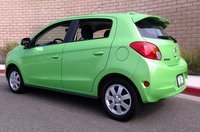
Corner handling around town, at posted speeds and not pushing any limits, was excellent. It shined when negotiating parking lots, parallel parking and other tight maneuver areas. The electrically power-assisted steering made turning the Mirage easy in-town but on the open road the steering feel was missing and numb. If you were even trying to get a little bit sporty, such as something as common as going 10 miles per hour over the posted speed limit on a freeway cloverleaf onramp, the Mirage was a handful. The front struts and rear Torsion beam suspension did not prevent the front drive Mirage from pushing and diving, resulting in significant body roll. Maybe it was the skinny, 14-inch low-resistance tires, but it became apparent that adhering to the speed limit was a good idea.
On the freeway, where you would think Mitsubishi must have designed the Mirage to spend most of its time with the class-leading 44 mpg, it was even more of an adventure. The little three-banger suffered from being buzzy and groaning to get up to speed. Then, when reaching 70 mph, there was a constant droning accompanied by hearing and feeling every bump and crack on the road. Driving the Mirage is akin to driving a go-cart – momentum is the key. Passing cars on the freeway takes forethought and some quick distance-to-speed calculations. The speedometer pegs-out at 105 mph, but when I got it to 80, I knew I had pushed it far enough for my comfort.
The Mirage did cruise along at a steady 65 mph, but you really would not want to do it for long, as the driver and front passenger seats only provide a marginally comfortable seating position. Exiting the car after one hour on the freeway, I felt beat-up as lower back and thigh support is minimal, which are the two biggest factors in driver fatigue. The rear bench seat did fit three adults (though two would be far more realistic) with good head and legroom but offered even less support than the front buckets. Add-in the Mirage’s noisy freeway running and a daily commute would not be a highlight of anyone’s life.
Driving Experience: Exterior
For the most part the 2014 Mitsubishi Mirage is an invisible car. Sure you can see it, but remembering what you saw is like looking at a car in a fog; it doesn’t really have a lasting imprint on your memory. There is nothing distinguishable about the car’s design with the only exception that Mitsubishi for 2014 has allowed the car to be painted in bubblegum shades of Kiwi Green and Plasma Purple along with the standard blue, white black, gray and silver.
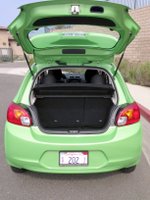
Driving Experience: Interior
The dash and center stack, with a piano black panel and silver trim accents, was very easy to use and figure-out. It has an old-school look and feel with a combination of knobs, switches and buttons. A dash screen with navigation and a rearview camera is an option.
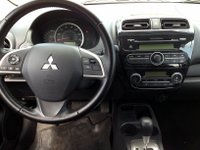
The Mirage ES Clean Fleet Report was testing is a $1,200 upgrade from the base model DE and had a leather-wrapped, tilt steering wheel with audio (volume and modes), hands-free phone and cruise control buttons. It also had keyless access with an optional engine start/stop button that for some reason the Mitsubishi designers placed on the left side of the steering wheel. Maybe they thought the Mirage was the next Porsche?
The four-speaker, AM/FM/CD player with an aux-in jack included SiriusXM, iPod connectivity and hands-free phone via Bluetooth wireless technology. The voice recognition was good, but it was necessary to speak clearly, directly and loudly at the ceiling-integrated microphone when on the freeway, where road noise is noticeable.
I’ve already mentioned the lack of seat comfort, cabin noise from the engine, weak CVT and road noise, but another factor that would lead to a good driving experience is something as simple as armrests. The armrests in the doors are made of a hard plastic that was uncomfortable, and there isn’t one at all in the center console. Well, to be fair, there isn’t a center console. Therefore, the driver’s right and front passenger’s left arms are left hanging.
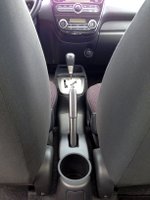
The 60/40 split fold-down rear seat, which folds almost flat, provides good storage space and there is a cargo cover.
The Mirage ES is nicely equipped with power windows, door locks and mirrors, rear window wiper/washer, A/C with automatic climate control, floor mats, 12V power outlet and three cup holders.
Safety and Convenience
The 2014 Mitsubishi Mirage ES safety and convenience features include side turn indicators, TPMS (Tire Pressure Monitoring System), anti-theft engine immobilizer, fog lamps and halogen headlights, seven airbags, stability and traction control, ABS with electronic brake distribution and brake assist.
Pricing and Warranties
Base pricing for the 2014 Mitsubishi Mirage:
DE Manual $12,995
DE CVT $13,995
ES Manual $14,195
ES CVT $15.195
The only option is the Navigation Package for $900.
These prices do not include the $795 Destination Charge.
The Mirage ES CVT model we were driving, without the Navigation Package, had a MSRP, including the Destination Charge, of $15,990.
The 2014 Mitsubishi Mirage comes with these warranties:
- 5-year/60,000-mile Basic
- 10-year/100,000-mile Powertrain
- 7-year/100,000-mile Anti-Corrosion
Observations: 2014 Mitsubishi Mirage ES
The 2014 Mitsubishi Mirage (in its first year in the Mitsubishi line-up) is carried-over in features and design for the 2015 model year. In both years you will find a basic transportation, high fuel economy car that is about as inexpensive to get into as anything on the market. It also carries an attractive warranty, meaning that the overall cost of ownership (purchase + insurance + fuel + maintenance) will be low and easily budgeted for many years.

Mitsubishi is upfront, saying that the Mirage is not about performance – and is that ever a true statement. The engine is underpowered and the CVT for all its fuel-sipping attributes, is not a good match with the low horsepower engine. The small tires and lack-of-feel electrically assisted steering make it easy to park and scoot around town but on the open road, there is not so much fun or confidence.

Within the small car or sub-compact category there are several vehicles to choose from that may cost a bit more and get a few less miles per gallon, but are worth consideration. This would include the Mazda2, Chevrolet Spark, Hyundai Accent, Kia Rio, Toyota Yaris, Ford Fiesta and Nissan Versa.
Clean Fleet Report hopes that Mitsubishi does some retooling on the Mirage to take it up a notch to improve the build quality, horsepower, torque, suspension and handling. Will doing so still make it the least expensive small car to own and operate? Maybe not, but it would probably be worth it in sales and reputation.
Right now the Mirage is Mitsubishi’s #2 selling car, behind their Outlander Sport, which is a 5-seat SUV. For Mitsubishi to gain shopping and buying consideration from consumers, and to move toward the class that includes Chevrolet, Ford, Honda, Hyundai, Kia, Mazda and Toyota, the Mirage will need to be a shining light in the competitive field of small cars. We hope they start moving that direction.
Whatever you end up buying, enjoy your new car and as always, Happy Driving!
Related stories you might enjoy:
Road Test: 2014 Nissan Versa Note
First Drive: 2015 Volkswagen Golf
Road Test: 2014 Toyota Prius c

Interesting comment- “the CVT for all its fuel-sipping attributes, is not a good match with the low horsepower engine”. So a transmission that’s designed to keep an engine operating at its most efficient rpm range at all times, isn’t a good match for a car with a small, low powered engine? What are the alternatives? Having spent several years pushing 68 horsepower Mercedes 240D’s around town with both 4 speed automatic and manual transmissions, I know from experience that neither of those options match up any better with a low powered engine. Mitsubishi could have put a 5 or 6 speed automatic in the Mirage, or it could have bumped the engine up to an inline 4 that puts out 100 horsepower. Either of those would have improved the car’s performance, but at the expense of fuel mileage and purchase price.
My 2015 Mirage with the CVT routinely gets 46-48 mpg on the freeway while cruising at 65-70 mph, and I’ve never had to drive half a mile down the freeway on the shoulder while trying to get up to merging speed after coming off the entrance like I used to with the 240D’s periodically. That seems like a car whose engine and transmission are reasonably well matched to me.
@Mercedes Convert,
First off, congratulations on getting such amazing fuel highway economy (46-48 mpg), especially since your 2015 Mirage is rated by the EPA at 42 highway mpg.
My point was that the CVT and three-cylinder engine are not an ideal combination for most driving situations. The fact you are comfortable with the power in your car is fine, but for most people they would prefer more power even if it means reduced fuel economy or a more expensive car. An example is the 2016 Scion iA with the four-cylinder 1.5L and automatic transmission, with an EPA rating of 33 city/42 highway/37 combined, which is nearly comparable to the 2017 Mirage G4 we tested. The difference in the two cars for quality, fit and finish, ride comfort and performance is considerable. The MSRP between the two with automatic transmissions, is $15,995 for the 2017 Mirage G4 and $16,800 for the 2016 Scion iA.
For less than $1,000 more the Scion iA would be the better car. –John Faulkner